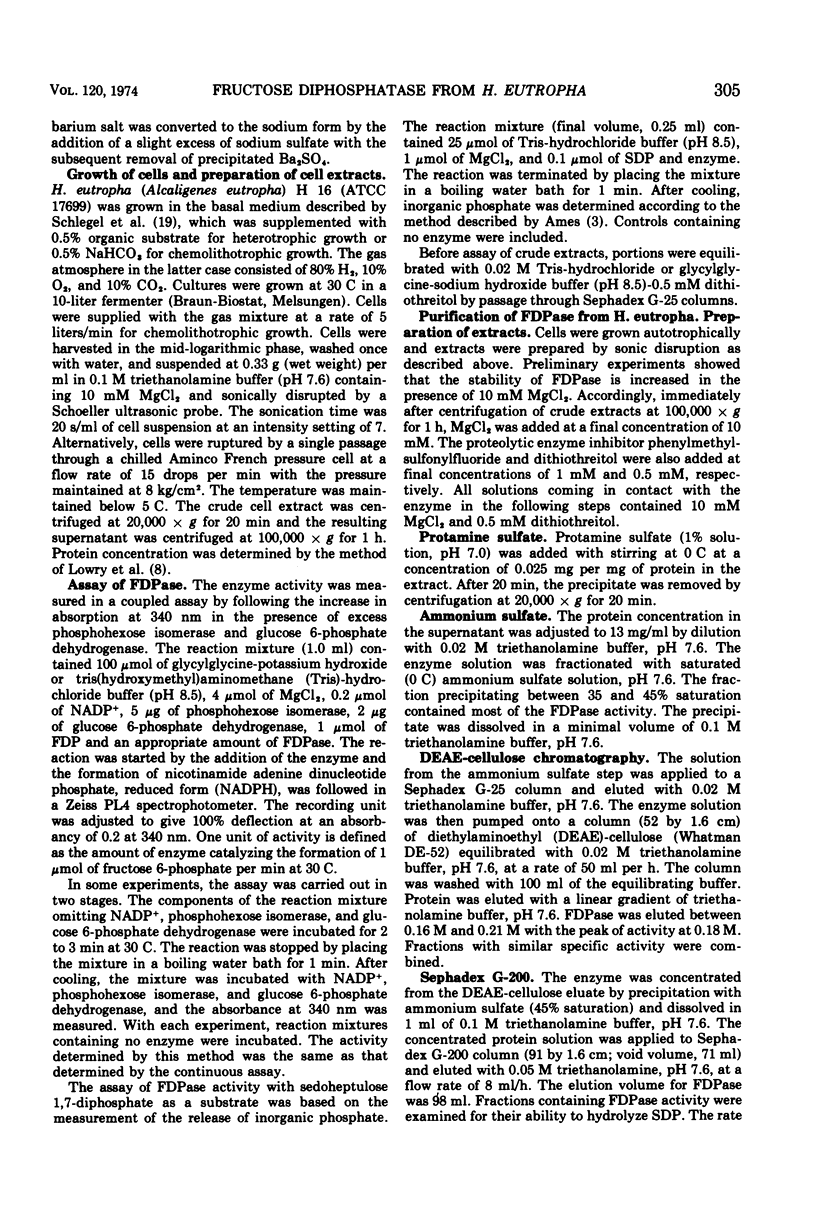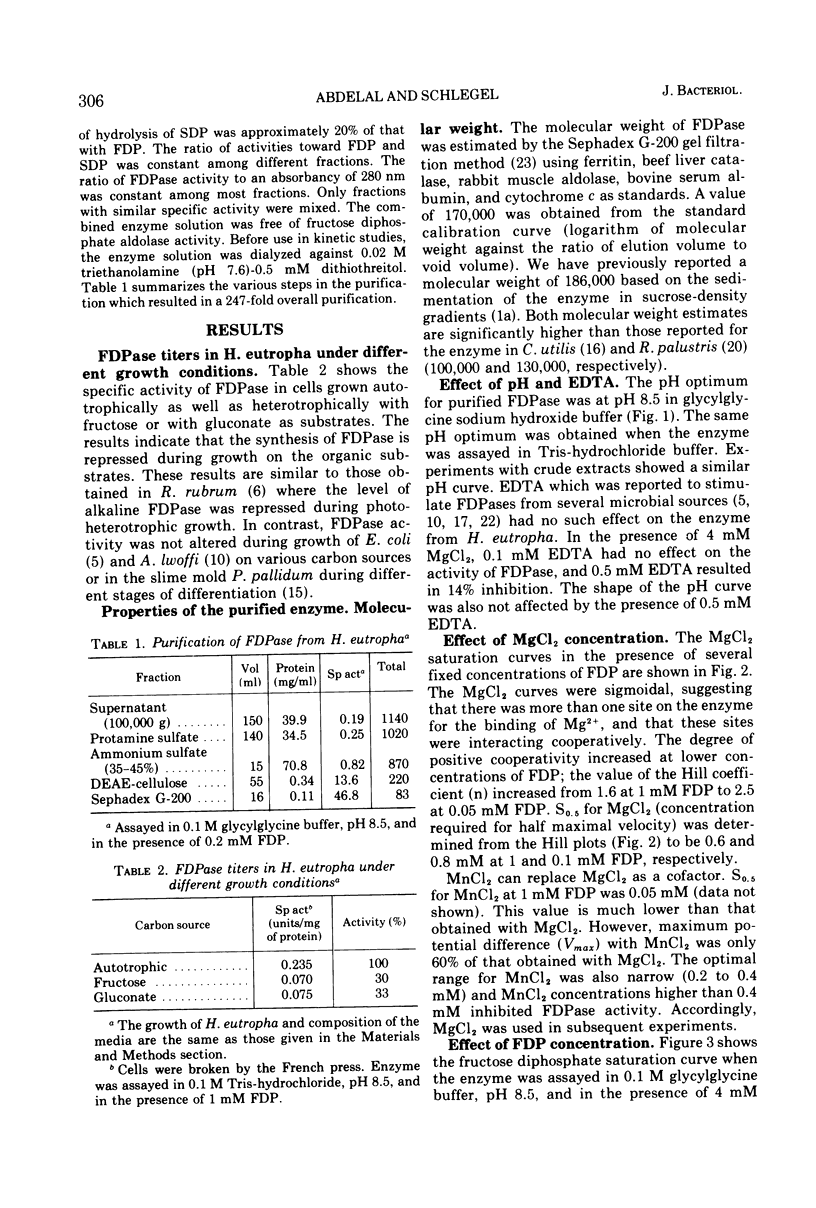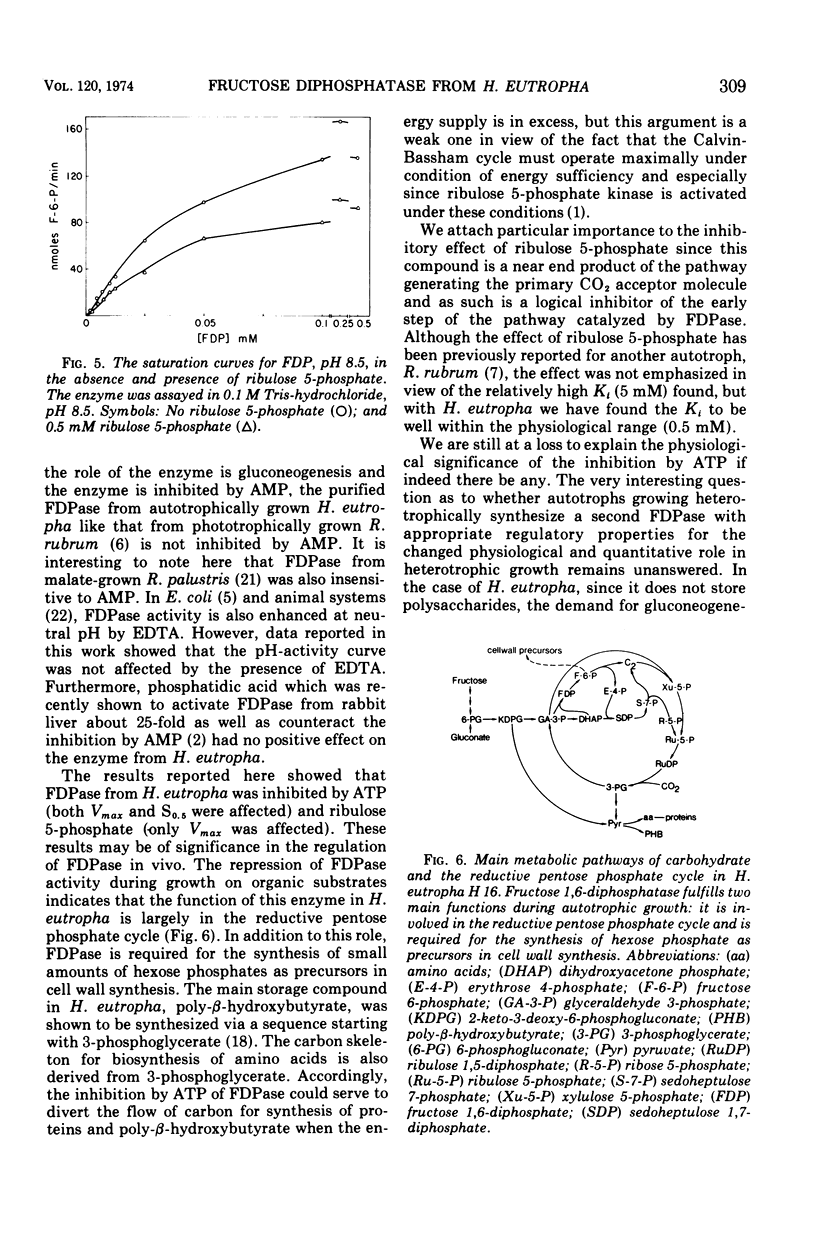Abstract
Fructose diphosphatase of Hydrogenomonas eutropha H 16, produced during autotrophic growth, was purified 247-fold from extracts of cells. The molecular weight of the enzyme was estimated to be 170,000. The enzyme showed a pH optimum of 8.5 in both crude extracts and purified preparation. The shape of the pH curve was not changed in the presence of ethylenediaminetetraacetic acid. The enzyme required Mg2+ for activity. The MgCl2 saturation curve was sigmoidal and the degree of positive cooperativity increased at lower fructose diphosphate concentrations. Mn2+ can replace Mg2+, but maximal activity was lower than that observed with Mg2+ and the optimal concentration range was narrow. The fructose diphosphate curve was also sigmoidal. The purified enzyme also hydrolyzed sedoheptulose diphosphate but at a much lower rate than fructose diphosphate. The enzyme was not inhibited by adenosine 5′-monophosphate but was inhibited by ribulose 5-phosphate and adenosine 5′-triphosphate. Adenosine 5′-triphosphate did not affect the degree of cooperativity among the sites for fructose diphosphate. The inhibition by adenosine 5′-triphosphate was mixed and by ribulose 5-phosphate was noncompetitive. An attempt was made to correlate the properties of fructose diphosphatase from H. eutropha with its physiological role during autotrophic growth.
Full text
PDF






Selected References
These references are in PubMed. This may not be the complete list of references from this article.
- Abdelal A. T., Schlegel H. G. Purification and regulatory properties of phosphoribulokinase from Hydrogenomonas eutropha H 16. Biochem J. 1974 Jun;139(3):481–489. doi: 10.1042/bj1390481. [DOI] [PMC free article] [PubMed] [Google Scholar]
- Abdelal A. T., Schlegel H. G. Separation of phosphoribulokinase from enzymes of the Calvin cycle in Hydrogenomonas eutropha H 16. Arch Mikrobiol. 1974 Feb 1;95(2):139–143. doi: 10.1007/BF02451755. [DOI] [PubMed] [Google Scholar]
- Allen M. B., Blair J. M. The regulation of rabbit liver fructose 1,6-diphosphatase activity by phospholipids in vitro. Biochem J. 1972 Dec;130(4):1167–1169. doi: 10.1042/bj1301167. [DOI] [PMC free article] [PubMed] [Google Scholar]
- Black W. J., Van Tol A., Fernando J., Horecker B. L. Isolation of ahighly active fructose diphosphatase from rabit muscle: its subunit structure and activation by monovalent cations. Arch Biochem Biophys. 1972 Aug;151(2):576–590. doi: 10.1016/0003-9861(72)90535-8. [DOI] [PubMed] [Google Scholar]
- Fraenkel D. G., Pontremoli S., Horecker B. L. The specific fructose diphosphatase of Escherichia coli: properties and partial purification. Arch Biochem Biophys. 1966 Apr;114(1):4–12. doi: 10.1016/0003-9861(66)90298-0. [DOI] [PubMed] [Google Scholar]
- Joint I. R., Morris I., Fuller R. C. Possible regulatory characteristics of the fructose diphosphatase--phosphoribulokinase complex from Rhodospirillum rubrum. Biochim Biophys Acta. 1972 Jul 13;276(1):333–337. doi: 10.1016/0005-2744(72)90037-x. [DOI] [PubMed] [Google Scholar]
- Joint I. R., Morris I., Fuller R. C. Purification of a complex of alkaline fructose 1,6-bisphosphatase and phosphoribulokinase from Rhodospirillum rubrum. J Biol Chem. 1972 Aug 10;247(15):4833–4838. [PubMed] [Google Scholar]
- LOWRY O. H., ROSEBROUGH N. J., FARR A. L., RANDALL R. J. Protein measurement with the Folin phenol reagent. J Biol Chem. 1951 Nov;193(1):265–275. [PubMed] [Google Scholar]
- Morris I. Inhibitor of spinach chloroplast fructose-1,6-diphosphatase by MgATP--,MgADP-and magnesium pyrophosphate (MgP207--). Biochim Biophys Acta. 1968 Oct 1;162(3):462–464. doi: 10.1016/0005-2728(68)90134-5. [DOI] [PubMed] [Google Scholar]
- Mukkada A. J., Bell E. J. Partial purification and properties of the fructose-1,6-diphosphatase from Acinetobacter lwoffi. Arch Biochem Biophys. 1971 Jan;142(1):22–31. doi: 10.1016/0003-9861(71)90255-4. [DOI] [PubMed] [Google Scholar]
- O'SULLIVAN W. J., PERRIN D. D. THE STABILITY CONSTANTS OF METAL-ADENINE NUCLEOTIDE COMPLEXES. Biochemistry. 1964 Jan;3:18–26. doi: 10.1021/bi00889a005. [DOI] [PubMed] [Google Scholar]
- PONTREMOLI S., MANGIAROTTI G. A simple method for the preparation of D-ribulose 5-phosphate. J Biol Chem. 1962 Mar;237:643–645. [PubMed] [Google Scholar]
- Preiss J., Biggs M. L., Greenberg E. The effect of magnesium ion concentration on the pH optimum of the spinach leaf alkaline fructose diphosphatase. J Biol Chem. 1967 May 10;242(9):2292–2294. [PubMed] [Google Scholar]
- Rosen O. M., Copeland P. L., Rosen S. M. The dissociation of D-fructose 1,6-diphosphatase by adenosine 5'-phosphate. J Biol Chem. 1967 Jun 10;242(11):2760–2763. [PubMed] [Google Scholar]
- Rosen O. M. Purification and properties of fructose 1,6-diphosphatase from Polysphondylium pallidum. Arch Biochem Biophys. 1966 Apr;114(1):31–37. doi: 10.1016/0003-9861(66)90301-8. [DOI] [PubMed] [Google Scholar]
- Rosen O. M., Rosen S. M., Horecker B. L. Purification and properties of a specific fructose 1,6-diphosphatase from Candida utilis. Arch Biochem Biophys. 1965 Dec;112(3):411–420. doi: 10.1016/0003-9861(65)90073-1. [DOI] [PubMed] [Google Scholar]
- SCHLEGEL H. G., KALTWASSER H., GOTTSCHALK G. [A submersion method for culture of hydrogen-oxidizing bacteria: growth physiological studies]. Arch Mikrobiol. 1961;38:209–222. [PubMed] [Google Scholar]
- Springgate C. F., Stachow C. S. Fructose 1,6-diphosphatase from Rhodopseudomonas palustris. I. Purification and properties. Arch Biochem Biophys. 1972 Sep;152(1):1–12. doi: 10.1016/0003-9861(72)90186-5. [DOI] [PubMed] [Google Scholar]
- Springgate C. F., Stachow C. S. Fructose 1,6-diphosphatase from Rhodopseudomonas palustris. II. Regulatory properties. Arch Biochem Biophys. 1972 Sep;152(1):13–20. doi: 10.1016/0003-9861(72)90187-7. [DOI] [PubMed] [Google Scholar]
- Van Tol A., Black W. J., Horecker B. L. Activation of rabbit muscle fructose diphosphatase by EDTA and the effect of divalent cations. Arch Biochem Biophys. 1972 Aug;151(2):591–596. doi: 10.1016/0003-9861(72)90536-x. [DOI] [PubMed] [Google Scholar]


